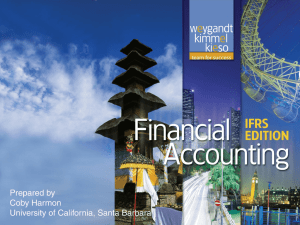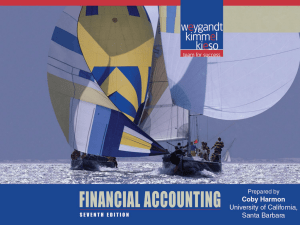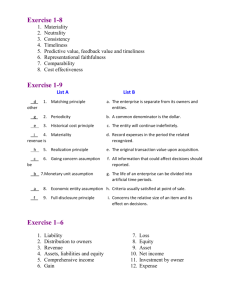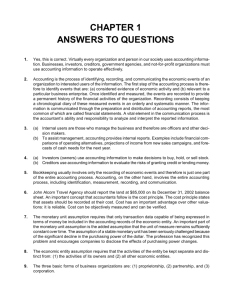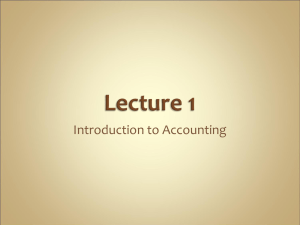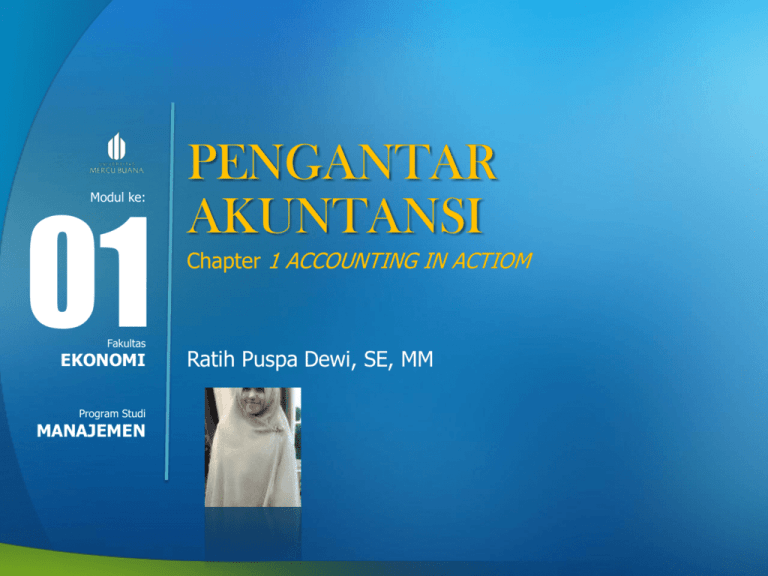
01
Modul ke:
Fakultas
EKONOMI
Program Studi
MANAJEMEN
PENGANTAR
AKUNTANSI
Chapter 1 ACCOUNTING IN ACTIOM
Ratih Puspa Dewi, SE, MM
Accounting in Action
PENGANTAR AKUNTANSI 1
PERTEMUAN KE 1 “ACCOUNTING in ACTION”
Study Objectives
1.
Identify the users and uses of accounting.
2.
Understand why ethics is a fundamental business concept.
3.
Explain accounting standards and the measurement principles.
4.
Explain the monetary unit assumption and the economic entity
assumption.
5.
State the accounting equation, and define its components.
6.
Analyze the effects of business transactions on the accounting
equation.
7.
Understand the four financial statements and how they are
prepared.
Accounting in Action
What is
Accounting?
Three
activities
Who uses
accounting
data?
The Building
Blocks of
Accounting
The Basic
Accounting
Equation
Ethics in
financial
reporting
Assets
Accounting
standards
Assumptions
Liabilities
Equity
Using the
Accounting
Equation
Financial
Statements
Transaction
analysis
Income
statement
Summary of
transactions
Retained
earnings
statement
Statement of
financial
position
Statement of
cash flows
What is Accounting?
The purpose of accounting:
(1)
to identify, record, and communicate the economic events of an
(2)
organization to
(3)
interested users.
SO 1 Explain what accounting is.
What is Accounting?
Three Activities
Illustration 1-1
The activities of the
accounting process
The accounting process includes
the bookkeeping function.
SO 1 Explain what accounting is.
What is Accounting?
Who Uses Accounting Data
Internal
Users
Human
Resources
External
Users
Taxing
Authorities
Labor
Unions
Finance
Management
Customers
Creditors
Marketing
Regulatory
Agencies
Investors
SO 2 Identify the users and uses of accounting.
Common Questions Asked
What is Accounting?
User
1. Can we afford to give our
employees a pay raise?
Human Resources
2. Did the company earn a
satisfactory income?
Investors
3. Should any product lines be
eliminated?
Management
4. Is cash sufficient to pay
dividends to shareholders?
Finance
5. What price for our product will
maximize net income?
Marketing
6. Will the company be able to
pay its debts?
Creditors
SO 2 Identify the users and uses of accounting.
The Building Blocks of
Accounting
Ethics In Financial Reporting
Standards of conduct by which one’s actions are judged as right or wrong,
honest or dishonest, fair or not fair, are Ethics.
Recent financial scandals include: Enron (USA),
Parmalat (ITA), Satyam Computer Services (IND), AIG
(USA), and others.
Effective financial reporting depends on sound ethical
behavior.
SO 3 Understand why ethics is a fundamental business concept.
The Building Blocks of
Accounting
Ethics In Financial Reporting
SO 3 Understand why ethics is a fundamental business concept.
The Building Blocks of Accounting
Review Question
Ethics are the standards of conduct by which one's actions are judged
as:
a. right or wrong.
b. honest or dishonest.
c. fair or not fair.
d. all of these options.
Solution on
notes page
SO 3 Understand why ethics is a fundamental business concept.
The Building Blocks of Accounting
Accounting Standards
International Accounting Standards Board (IASB)
http://www.iasb.org/
International Financial Reporting Standards (IFRS)
Financial Accounting Standards Board (FASB)
http://www.fasb.org/
Generally Accepted Accounting Principles (GAAP)
SO 4 Explain accounting standards and the measurement principles.
The Building Blocks of
Accounting
Measurement Principles
Cost Principle (Historical) – dictates that companies record
assets at their cost.
Issues:
Reported at cost when purchased and also over the time the
asset is held.
Cost easily verified, market value is often subjective.
Fair value information may be more useful.
SO 4 Explain accounting standards and the measurement principles.
The Building Blocks of
Accounting
Measurement Principles
Fair Value Principle – indicates that assets and liabilities should
be reported at fair value.
In determining which measurement principle to use, companies
weigh the factual nature of cost figures versus the relevance of
fair value.
Only in situations where assets are actively traded, such as
investment securities, is the fair value principle applied.
SO 4 Explain accounting standards and the measurement principles.
The Building Blocks of Accounting
Assumptions
Monetary Unit Assumption – include in the accounting records
only transaction data that can be expressed in terms of money.
Economic Entity Assumption – requires that activities of the
entity be kept separate and distinct from the activities of its
owner and all other economic entities.
Proprietorship.
Partnership.
Forms of Business
Ownership
Corporation.
SO 5 Explain the monetary unit assumption and the economic entity assumption.
The Building Blocks of Accounting
Proprietorship
Partnership
Corporation
Generally owned
by one person.
Owned by two or
more persons.
Ownership divided
into shares
Often small
service-type
businesses
Often retail and
service-type
businesses
Owner receives
any profits, suffers
any losses, and is
personally liable for
all debts.
Generally unlimited
personal liability
Separate legal
entity organized
under state
corporation law
Limited liability
Partnership
agreement
SO 5 Explain the monetary unit assumption and the economic entity assumption.
The Building Blocks of Accounting
Review Question
Combining the activities of Kellogg and General Mills would violate the
a. cost principle.
b. economic entity assumption.
c. monetary unit assumption.
d. ethics principle.
Solution on
notes page
SO 5 Explain the monetary unit assumption
and the economic entity assumption.
The Building Blocks of Accounting
Review Question
A business organized as a separate legal entity under state law having
ownership divided into shares is a
a. proprietorship.
b. partnership.
c. corporation.
d. sole proprietorship.
Solution on
notes page
SO 5 Explain the monetary unit assumption
and the economic entity assumption.
The Building Blocks of Accounting
Indicate whether each of the following
statements presented below is true or false.
1. The three steps in the accounting process are
identification, recording, and communication.
True
2. The two most common types of external users
are investors and company officers.
3. Shareholders in a corporation enjoy limited legal
liability as compared to partners in a partnership.
Solution on
notes page
False
True
SO 5 Explain the monetary unit assumption
and the economic entity assumption.
The Building Blocks of Accounting
Indicate whether each of the following
statements presented below is true or false.
4. The primary accounting standard-setting body
outside the United States is the International
True
Accounting Standards Board (IASB).
5. The cost principle dictates that companies
record assets at their cost. In later periods,
False
however, the fair value of the asset must be
used if fair value is higher than its cost.
Solution on
notes page
SO 5 Explain the monetary unit assumption
and the economic entity assumption.
Answer on notes page
SO 5 Explain the monetary unit assumption and the economic entity assumption.
The Basic Accounting Equation
Assets
=
Liabilities
+
Equity
Provides the underlying framework for recording and summarizing
economic events.
Applies to all economic entities regardless of size.
SO 6
State the accounting equation, and define its components.
The Basic Accounting Equation
Assets
=
Liabilities
+
Equity
Provides the underlying framework for recording and summarizing
economic events.
Assets
Resources a business owns.
Provide future services or benefits.
Cash, Inventory, Equipment, etc.
SO 6
State the accounting equation, and define its components.
The Basic Accounting Equation
Assets
=
Liabilities
+
Equity
Provides the underlying framework for recording and summarizing
economic events.
Liabilities
Claims against assets (debts and obligations).
Creditors - party to whom money is owed.
Accounts payable, Notes payable, etc.
SO 6
State the accounting equation, and define its components.
The Basic Accounting Equation
Assets
=
Liabilities
+
Equity
Provides the underlying framework for recording and summarizing
economic events.
Equity
Ownership claim on total assets.
Referred to as residual equity.
Share capital and retained earnings.
SO 6
State the accounting equation, and define its components.
The Basic Accounting Equation
Illustration 1-7
Revenues result from business activities entered into for the purpose
of earning income.
Generally results from selling merchandise, performing services,
renting property, and lending money.
SO 6
State the accounting equation, and define its components.
The Basic Accounting Equation
Illustration 1-7
Expenses are the cost of assets consumed or services used in the
process of earning revenue.
Common expenses are salaries expense, rent expense, utilities
expense, tax expense, etc.
SO 6
State the accounting equation, and define its components.
The Basic Accounting Equation
Illustration 1-7
Dividends are the distribution of cash or other assets to shareholders.
Reduce retained earnings
Not an expense
SO 6
State the accounting equation, and define its components.
The Basic Accounting Equation
Classify the following items as issuance of
shares, dividends, revenues, or expenses.
Then indicate whether each item increases or decreases
equity.
Classification
Effect on Equity
1. Rent expense
Expense
Decrease
2. Service revenue
Revenue
Increase
3. Dividends
Dividends
Decrease
4. Salaries expense
Expense
Decrease
Solution on
notes page
SO 6
State the accounting equation, and define its components.
Using The Accounting Equation
Transactions are a business’s economic events recorded by
accountants.
May be external or internal.
Not all activities represent transactions.
Each transaction has a dual effect on the accounting
equation.
SO 7
Analyze the effects of business transactions on the accounting equation.
Using The Accounting Equation
Illustration: Are the following events recorded in the accounting records?
Purchase
computer.
Event
Discuss
product
design with
customer.
Illustration 1-8
Pay rent.
Is the financial position (assets, liabilities, or
equity) of the company changed?
Criterion
Record/ Don’t
Record
SO 7
Analyze the effects of business transactions on the accounting equation.
Using The Accounting Equation
Transaction Analysis
SO 7
Analyze the effects of business transactions on the accounting equation.
Transactions Analysis
Transaction (1). Investment by Shareholders. Ray and
Barbara Neal decides to open a computer programming service
which he names Softbyte. On September 1, 2011, they invest
$15,000 cash in exchange for capital shares. The effect of this
transaction on the basic equation is:
Solution on
notes page
SO 7
Analyze the effects of business transactions
on the accounting equation.
Transactions Analysis
Transaction (2). Purchase of Equipment for Cash. Softbyte
purchases computer equipment for $7,000 cash.
Solution on
notes page
SO 7
Analyze the effects of business transactions
on the accounting equation.
Transactions Analysis
Transaction (3). Purchase of Supplies on Credit. Softbyte
purchases for $1,600 from Acme Supply Company computer
paper and other supplies expected to last several months.
Solution on
notes page
SO 7
Analyze the effects of business transactions
on the accounting equation.
Transactions Analysis
Transaction (4). Services Provided for Cash. Softbyte
receives $1,200 cash from customers for programming services
it has provided.
Solution on
notes page
SO 7
Analyze the effects of business transactions
on the accounting equation.
Transactions Analysis
Transaction (5). Purchase of Advertising on Credit. Softbyte
receives a bill for $250 from the Daily News for advertising but
postpones payment until a later date.
Solution on
notes page
SO 7
Analyze the effects of business transactions
on the accounting equation.
Transactions Analysis
Transaction (6). Services Provided for Cash and Credit.
Softbyte provides $3,500 of programming services for
customers. The company receives cash of $1,500 from
customers, and it bills the balance of $2,000 on account.
Solution on
notes page
SO 7
Analyze the effects of business transactions
on the accounting equation.
Transactions Analysis
Transaction (7). Payment of Expenses. Softbyte pays the
following Expenses in cash for September: store rent $600,
salaries of employees $900, and utilities $200.
Solution on
notes page
SO 7
Analyze the effects of business transactions
on the accounting equation.
Transactions Analysis
Transaction (8). Payment of Accounts Payable. Softbyte
pays its $250 Daily News bill in cash.
Solution on
notes page
SO 7
Analyze the effects of business transactions
on the accounting equation.
Transactions Analysis
Transaction (9). Receipt of Cash on Account. Softbyte
receives $600 in cash from customers who had been billed for
services [in Transaction (6)].
Solution on
notes page
SO 7
Analyze the effects of business transactions
on the accounting equation.
Transactions Analysis
Transaction (10). Dividends. The corporation pays a dividend
of $1,300 in cash.
Solution on
notes page
SO 7
Analyze the effects of business transactions
on the accounting equation.
Transactions Analysis
Summary of Transactions
SO 7
Illustration 1-10
Tabular summary of
Softbyte transactions
Analyze the effects of business transactions on the accounting equation.
Financial Statements
Companies prepare four financial statements from the summarized
accounting data:
Income
Statement
Retained
Earnings
Statement
Statement of
Financial
Position
Statement of
Cash Flows
SO 8 Understand the four financial statements and how they are prepared.
Financial Statements
Review Question
Net income will result during a time period when:
a. assets exceed liabilities.
b. assets exceed revenues.
c. expenses exceed revenues.
d. revenues exceed expenses.
Solution on
notes page
SO 8 Understand the four financial statements and how they are prepared.
Financial Statements
Income Statement
Reports the revenues and expenses for a specific period of time.
Net income – revenues exceed expenses.
Illustration 1-11
Financial statements and
Net loss – expenses exceed revenues.
their interrelationships
SO 8 Understand the four financial statements and how they are prepared.
Financial Statements
Net income is needed to determine the
ending balance in retained earnings.
Illustration 1-11
Financial statements and
their interrelationships
SO 8
Retained Earnings
Statement
Financial Statements
Statement indicates the reasons why
retained earnings has increased or
decreased during the period.
Illustration 1-11
Financial statements and
their interrelationships
SO 8 Understand the four financial statements and how they are prepared.
Financial
Statements
The ending
balance in
retained
earnings is
needed in
preparing the
statement of
financial position
Illustration 1-11
Financial statements and
their interrelationships
SO 8 Understand the four financial statements and how they are prepared.
Financial Statements
Balance Sheet
Illustration 1-11
Financial statements and
their interrelationships
SO 8 Understand the four financial statements and how they are prepared.
Financial
Statements
Illustration 1-11
Financial statements and
their interrelationships
Financial Statements
Statement of Cash Flows
Information for a specific period of time.
Answers the following:
1. Where did cash come from?
2. What was cash used for?
3. What was the change in the cash balance?
SO 8 Understand the four financial statements and how they are prepared.
Statement of Cash Flows
Financial Statements
Illustration 1-11
Financial statements and
their interrelationships
SO 8 Understand the four financial statements and how they are prepared.
Answer on
notes page
SO 8 Understand the four financial statements and how they are prepared.
Financial Statements
Review Question
Which of the following financial statements is prepared as of a specific
date?
a. Balance sheet.
b. Income statement.
c. Retained earnings statement.
d. Statement of cash flows.
Solution on
notes page.
SO 8 Understand the four financial statements and how they are prepared.
Understanding U.S. GAAP
Key Differences
Accounting in Action
In 2002, the U.S. Congress issued the Sarbanes-Oxley Act (SOX),
which mandated certain internal controls for large public
companies listed on U.S. exchanges. Debate about international
companies (non-U.S.) adopting SOX-type standards centers on
whether the benefits exceed the costs. The concern is that the
higher costs of SOX compliance are making the U.S. securities
markets less competitive.
Financial frauds have occurred at companies such as Satyam
Computer Services (IND), Parmalat (ITA), and Royal Ahold (NLD).
They have also occurred at large U.S. companies such as Enron,
WorldCom, and AIG.
Understanding U.S. GAAP
Key Differences
Accounting in Action
IFRS tends to be less detailed in its accounting and disclosure
requirements than GAAP. This difference in approach has resulted
in a debate about the merits of “principles-based” (IFRS) versus
“rules-based” (GAAP) standards.
U.S. regulators have recently eliminated the need for foreign
companies that trade shares in U.S. markets to reconcile their
accounting with GAAP.
GAAP is based on a conceptual framework that is similar to that
used to develop IFRS.
Understanding U.S. GAAP
Key Differences
Accounting in Action
The three common forms of business organization that are
presented in the chapter, proprietorships, partnerships, and
corporations, are also found in the United States. Because the
choice of business organization is influenced by factors such as
legal environment, tax rates and regulations, and degree of
entrepreneurism, the relative use of each form will vary across
countries.
Transaction analysis is basically the same under IFRS and GAAP
but, as you will see in later chapters, the different standards may
impact how transactions are recorded.
Understanding U.S. GAAP
Looking to the Future
Accounting in Action
Both the IASB and the FASB are hard at work developing
standards that will lead to the elimination of major differences in
the way certain transactions are accounted for and reported.
Consider, for example, that as a result of a joint project on the
conceptual framework, the definitions of the most fundamental
elements (assets, liabilities, equity, revenues, and expenses) may
actually change. However, whether the IASB adopts internal
control provisions similar to those in SOX remains to be seen.
Career Opportunities
APPENDIX
Public accounting
Government
Private accounting
Forensic accounting
“Show me the
Money”
SO 9 Explain the career opportunities in accounting.
Copyright
Copyright © 2011 John Wiley & Sons, Inc. All rights reserved.
Reproduction or translation of this work beyond that permitted in
Section 117 of the 1976 United States Copyright Act without the
express written permission of the copyright owner is unlawful.
Request for further information should be addressed to the
Permissions Department, John Wiley & Sons, Inc. The purchaser
may make back-up copies for his/her own use only and not for
distribution or resale. The Publisher assumes no responsibility for
errors, omissions, or damages, caused by the use of these
programs or from the use of the information contained herein.
Terima Kasih
Ratih Puspa Dewi,SE,MM



